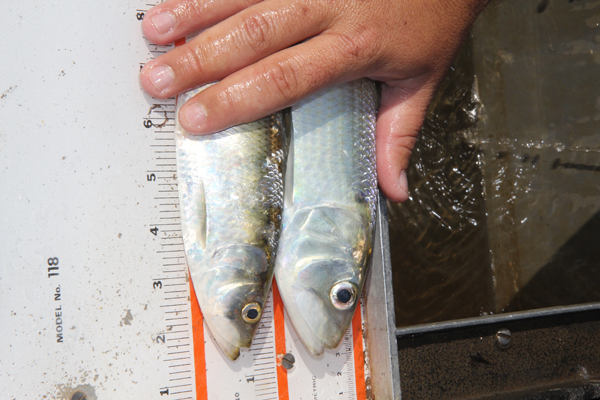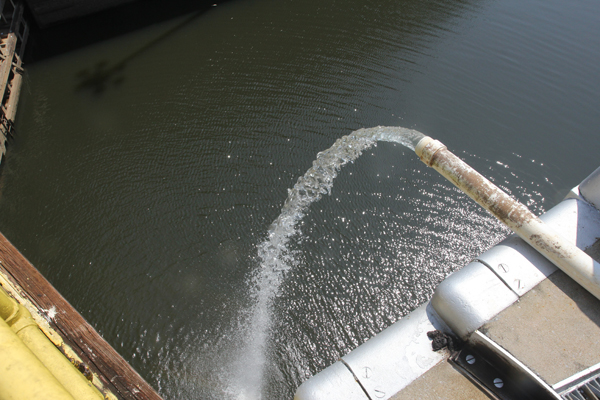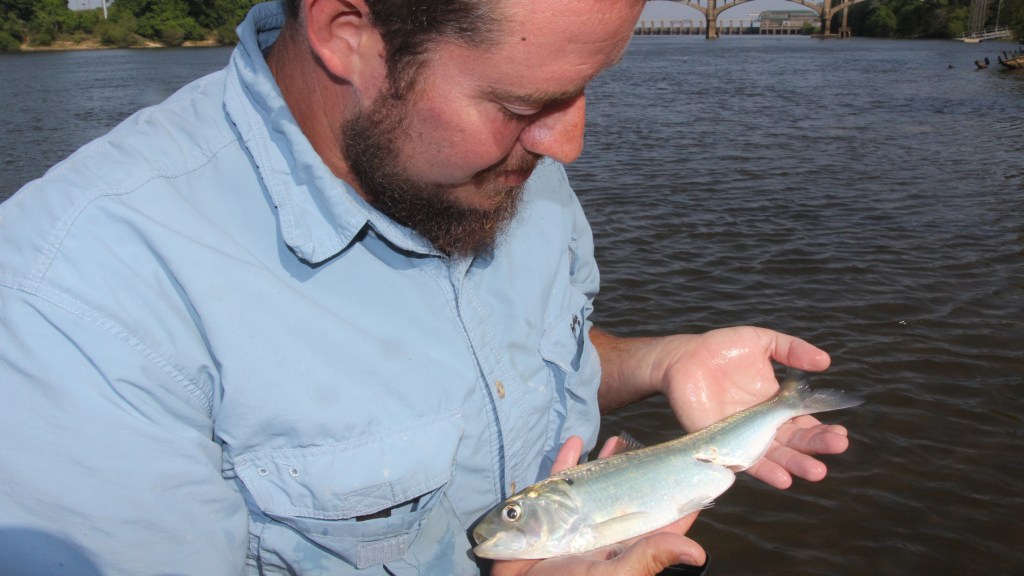Author’s Note: This blog originally ran a year ago, following time afield with shad researchers on Florida’s Apalachicola River. Recently, the researchers released new information with some exciting new results on Alabama shad restoration. This blog provides the background information on the project. Check back tomorrow for a look at the results of this project, which is making a big difference in migratory fish conservation.
Take PVC pipe. Attach to a home water pump. Add water.
It’s a simple recipe, but one that might be enough to help move millions of the migratory fish species known as Alabama shad over dams, so they can spawn in rivers throughout the southeastern United States. For millions of dollars less than conventional methods. With potentially big gains for sport fisheries in those rivers.
“It’s low cost, low risk and low tech,” says Steve Herrington, director of freshwater conservation for The Nature Conservancy in Florida. “You can buy any of the basic equipment at Home Depot. And we have the science to back it up.”
An Amazing Fish Story

Getting fish over dams typically costs huge sums. A fish ladder for even a small dam can run $2 to $4 million. Proposed fish ladders for Pacific salmon on four dams on the Klamath River were estimated to costs $250 million.
But you don’t hear about a dime for Alabama shad. Why? After all, the closely related American shad used to be as American as apple pie, the source of a major American canning industry in the American colonies, as covered in John McPhee’s excellent book, The Founding Fish. (Even George Washington had a cannery).
But today: “Most people don’t even know what a shad is,” says Herrington—even though some biologists think restoring the fish to the upper reaches of southeastern rivers could boost bass fishing there.
“We need to take what we know about the species and find cheap methods to help them migrate,” he says.
The Conservancy is working with partners from the Georgia Department of Natural Resources, Florida Fish and Wildlife Conservation Commission, U.S. Army Corps of Engineers U.S. Fish and Wildlife Service and the National Marine Fisheries Service to assemble a more complete picture of the shad — its life history, its migration patterns, its population status.
I recently joined Herrington, Auburn University research assistant Chase Katechis and Georgia DNR biologist Travis Ingram to catch and tag Alabama shad in the Apalachicola River, one of the largest rivers in the region.
As the team netted shad, I was able to see them up close: A plate-sized silvery fish that looks like it belongs in the ocean — and indeed, for much of its life it lives somewhere in the Gulf of Mexico (even scientists don’t know exactly where). In saltwater, it bulks up on other fish, but little else is known.
Come spring, shad surge up rivers like the Apalachicola. They don’t feed, instead putting their energy into reaching suitable spawning areas, where they lay eggs and (scientists think) die. The young shad migrate back to the ocean, continuing the cycle.
It’s a journey fraught with peril, as the fish I held so dramatically attested: Nearly every shad contained gashes on its side — the work of the longnose gar, a somewhat unsettling predatory fish with a protruding snout full of sharp teeth.
Overhead, ospreys carried other fish off in their talons.
But those perils are nothing compared to the biggest obstacle: a large dam that sat just upstream of our anchored boat.
In a Lock, the Key to Solving the Shad’s Problem

The dam’s exact effect on shad population declines wasn’t well known: little documentation exists for historic shad runs. But one thing was clear: shad weren’t getting past the dam, at least not in numbers that mattered. Fisheries surveys in the 1990’s noted few if any shad above the dam.
“The dam isn’t going away. It provides power for thousands of people,” says Herrington. “Given that, how can we work with it? How can we get fish over it without any money?”
There seemed to be a ready-made solution: A boat lock.
It operates as any lock does. A boat enters the lock at the bottom of the dam, as a door closes behind it. The lock fills with water (six million gallons in this case), raising the boat to the level of the impoundment behind the dam. A door opens and the boat exits above the dam.
Why not move fish the same way?
The problem was, fish didn’t know how to enter the lock.
Dams can be noisy places. As we captured fish, it was easy to ignore the background hum of a dam in operation: machines running, electric lines buzzing, the clanking of metal. For fish, though, it’s downright disorienting. How could they possibly figure out where to enter a lock?
Shad, it turns out, orient themselves on their migration through audible cues as well as river currents. The sound of running water is the sound of home. They instinctively follow that. There’s no sound of running water in a lock, especially when the door is open, at least not until now.
Enter the PVC pipe and water pump: the conservation equipment available for purchase at a home supply store near you.
The generator pumps water through the pipe, which is located above the lock. The water coursing through there sends a stream of water cascading into the lock below. It creates a loud splash. To fish, it’s like a road sign, or perhaps an old familiar song on the radio that takes you back to your youth.
The fish enter the lock, the water is raised, and they’ve successfully negotiated the dam.
Biologists like Herrington know this because they are catching fish and fitting them with radio transmitters, then tracking their movements. The fish are definitely entering the lock.
But there’s one other problem. “This is a very low use lock,” says Herrington. “Barges used to go through here regularly, but now there may be one or two a year.”
There are recreational boaters and anglers moving through the locks, but even then it may only be a couple of dozen lock passages a month—not enough to ensure consistent passage for fish.
Fortunately, the Army Corps of Engineers staff—who operate the lock—have agreed to run water and operate the lock twice per day when the fish are making their spring migration. Due to radio tracking, biologists know when the shad are most likely to be gathering at the dam ready to move (early morning and early afternoon), and that’s when they are lured into the lock.
It takes a little time from the dam operators, but very little money or water.
And the fish are moving.
The average population of shad from 2005 through 2009 was about 10,000, with low water levels likely affecting the spawning run despite conservation locking efforts. In 2010, with more water in the system, the fish populations was estimated at 98,000. Due to low water last year, 25,000 fish were estimated. This year, preliminary analysis estimates the population between 60,000 to 75,000. While numbers may fluctuate, these trends hold promise.
“We should know this year or next what the real potential is,” says Herrington. “Right now, we hypothesize the river could support a run of 500,000 or 600,000 shad, and possibly quite a bit more.”
Initially, some thought that even if shad could get over the dam, they couldn’t negotiate the reservoir and get to suitable spawning habitat.
They could.
More Shad, Bigger Bass?

Researchers are still filling in a lot of blanks on what remains a largely unknown fish.
For instance, some fisheries biologists believe that young shad may be an important food source for largemouth bass. In this part of the country, bass fishing is often mentioned—with no tongue in cheek—in the same sentence as religion. There are bass fishing clubs, bass fishing tournaments, bass fishing super-stores.
“Shad are off everybody’s radar. This fish was never a cultural or economic resource,” says Herrington. “But if you mention that shad might be an important food for largemouth bass, and could mean much larger bass, then it gets peoples’ attention. This restoration could have tremendous impacts on the sport fishery.”
Could more attention mean the shad join the salmon as an esteemed and valued migratory fish? That remains to be seen.
In the meantime, it’s PVC pipe conservation that’s shaping a hopeful future for the fish.
“We’ve taken the science we have on this little-known species, and used that to make conservation more successful,” says Herrington. “Right now, it looks like we are improving our fisheries, with little more cost than the gas that it takes to run a small generator.”




The second photo appears to show an Alabama shad on top of a skipjack herring. The skipjack has more slender body and its mouth is more “tarpon” like. Given the experience and knowledge of the biologists in charge of this project, I’m pretty sure misidentification is not a problem; however, field researchers need to make they are not misidentifying skipjack herring as Alabama shad. This could lead to false population estimates and passage estimates. With that in mind, keep up the good work!